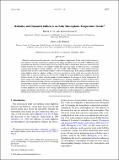Radiative and Dynamical Influences on Polar Stratospheric Temperature Trends
Author(s)
Rieder, Harald E.; Ivy, Diane J; Solomon, Susan
DownloadRadiative and dynamical.pdf (3.139Mb)
PUBLISHER_POLICY
Publisher Policy
Article is made available in accordance with the publisher's policy and may be subject to US copyright law. Please refer to the publisher's site for terms of use.
Terms of use
Metadata
Show full item recordAbstract
Radiative and dynamical heating rates control stratospheric temperatures. In this study, radiative temperature trends due to ozone depletion and increasing well-mixed greenhouse gases from 1980 to 2000 in the polar stratosphere are directly evaluated, and the dynamical contributions to temperature trends are estimated as the residual between the observed and radiative trends. The radiative trends are obtained from a seasonally evolving fixed dynamical heating calculation with the Parallel Offline Radiative Transfer model using four different ozone datasets, which provide estimates of observed ozone changes. In the spring and summer seasons, ozone depletion leads to radiative cooling in the lower stratosphere in the Arctic and Antarctic. In Arctic summer there is weak wave driving, and the radiative cooling due to ozone depletion is the dominant driver of observed trends. In late winter and early spring, dynamics dominate the changes in Arctic temperatures. In austral spring and summer in the Antarctic, strong dynamical warming throughout the mid- to lower stratosphere acts to weaken the strong radiative cooling associated with the Antarctic ozone hole and is indicative of a strengthening of the Brewer–Dobson circulation. This dynamical warming is a significant term in the thermal budget over much of the Antarctic summer stratosphere, including in regions where strong radiative cooling due to ozone depletion can still lead to net cooling despite dynamical terms. Quantifying the contributions of changes in radiation and dynamics to stratospheric temperature trends is important for understanding how anthropogenic forcings have affected the historical trends and necessary for projecting the future.
Date issued
2016-06Department
Massachusetts Institute of Technology. Department of Earth, Atmospheric, and Planetary SciencesJournal
Journal of Climate
Publisher
American Meteorological Society (AMS)
Citation
Ivy, Diane J., Susan Solomon, and Harald E. Rieder. “Radiative and Dynamical Influences on Polar Stratospheric Temperature Trends.” Journal of Climate 29, no. 13 (July 2016): 4927–4938. ©2016 American Meteorological Society.
Version: Final published version
ISSN
0894-8755
1520-0442